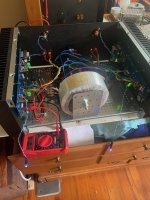These were EI cores totally encapsulated in steel. Wondered me straight away. They were so hot that one burned fingers by touching them. As the airflow normally generated by the machine also lacked they stayed hot for a long time. A down time that eventually would lead to yet other serious issues.
Since the device had to work I had to improvise getting it starting.
Since the device had to work I had to improvise getting it starting.
Last edited:
You've got enough other transformers I remember. 😊
Would you comtemplate an SMPS? I even use medical units that have a <5 pA leakage from mains to device, hence excellent for all communications and protocol-oriented signalling.
Would you comtemplate an SMPS? I even use medical units that have a <5 pA leakage from mains to device, hence excellent for all communications and protocol-oriented signalling.
No. I just do what is reliable and gives clean power. At work I would not like to do stuff linear but for low power audio SMPS are chosen for the wrong (often irrelevant) reasons.
Medical units have lower leakage but what about EMI/ripple/noise? What strikes me it that one nowadays has to defend simple, reliable and clean transformer based linear power supplies. One will not save the world by switching over to SMPS!
Medical units have lower leakage but what about EMI/ripple/noise? What strikes me it that one nowadays has to defend simple, reliable and clean transformer based linear power supplies. One will not save the world by switching over to SMPS!
Last edited:
Agree. Once Philips made transformers for their players with 'air coils', such that the coupling between line and secondary/case/equipment was often << 100 pF. A SMPS can hardly beat such a PS with a shunt for sensitive environments. But it is a lot of work.
[I'm now finishing a new PS for a prepre +/- 6.5V and I think I still have to take measures like 6 x 100.000µF. And I probably need to observe the minimum current of the SMPS.]
[I'm now finishing a new PS for a prepre +/- 6.5V and I think I still have to take measures like 6 x 100.000µF. And I probably need to observe the minimum current of the SMPS.]
You could use modern regulators like LT3045/3094 and normal value filter caps.
Yes linear is a lot of work but it does pay off.
Yes linear is a lot of work but it does pay off.
That was near the amps, no noise from speakers, the 'hiss' seemed to be on the recording but not something that was in the room
Can you try turning everything off in your home? Then see if it still hums. Also can you check ac voltage, core might be getting oversaturated.
My lovely F6 has a toroidal Antek transformer mounted with a bracket so it is standing on it's side in the case and it gives off a VERY low level hum, audible when near the Amp, and also though the speakers if you put your ear a foot or so from the speakers. I am putting some rubber padding under the transformer but also want to wrap it with aluminum foil in hopes of curtailing EMF interference on nearby wires. I know I have to be carefull about not shorting anything out. My question is, how effective can I expect aluminum foil to be as an EMF blocker?
That foil better be used to make a hat.
*Aluminium is not the right material and please be careful when packing transformers in conductive stuff.
*Aluminium is not the right material and please be careful when packing transformers in conductive stuff.
yes, you need to identify which type of humming so you can correct them correctly..
be ready to use polyurethane varnish to dip in your transformer...
be ready to use polyurethane varnish to dip in your transformer...
A picture is worth a thousand...perhaps this will help understand the situation. It is an ANTEK AS-4218.
PS- I want to eliminate the possibility of Type 3 hum, as described earlier in this thread. I think I've got the mechanical type fixed with a bit of rubber matting under the transformer.
PS- I want to eliminate the possibility of Type 3 hum, as described earlier in this thread. I think I've got the mechanical type fixed with a bit of rubber matting under the transformer.
Attachments
The speaker hum may be due to magnetic coupling between the signal and power transformers. Can you re-orient the power transformer?
Ed
Ed
Not Easily, that's why I'm considering shielding. This orientation was suggested as one of the better options to minimize interference.Can you re-orient the power transformer?
It may not be the orientation of the transformer itself that’s causing a problem. Two separate channels, separated by distance, with a power supply sitting smack dab in the middle is probably the best way to create a ground loop. Hint: the input cables close the loop, so think “outside the box/amplifier”. Just a little radiation, from anywhere, and hummmmmmmmmmm.
- Home
- Amplifiers
- Solid State
- Any tips for reducing transformer Hum?
